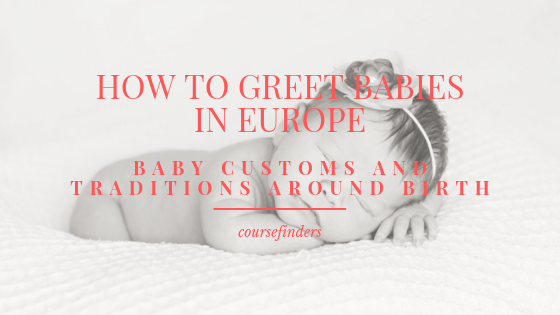In almost every country in the world, babies are welcomed in a special way when they are born. There are many traditions and customs that vary from country to country and sometimes even from region to region. For this article we have gathered together a number of different baby customs from all over Europe. Which of these did you already know?
You may have already experienced different traditions in holiday countries. The next time you’re in the country, take a close look around – and if you need tips on finding the right language school, then you’ve come to the right place on our website.
Baby customs and traditions in Germany
It is not only in Germany that the custom of planting baby trees is enjoying growing popularity. So when a baby is born, a so-called tree of life is planted in the parents’ garden. This tree then grows at the same time as the child.
Also known in Germany is the custom of so-called baby peeing. The arrival of the new earth citizen is celebrated and drunk vigorously. This custom is also known in Austria.
More and more in Germany is also the baby custom to set up a stork in front of the house of the newborn child. This stork remains standing until the new parents are accustomed to the new life, then the stork is picked up again. By the way, it is set up by friends or acquaintances.
In Bavaria, cans or rags are hung from the newborn’s house to show which sex the baby has. In cities this custom is not so common anymore, but in villages it is still justified.
A nice custom is also to put on a memory box for the baby. It contains, for example, a maternity record, the first pacifier, the first shoes, self-painted pictures, photos and so on, and is given to the child on his 18th birthday.
In Germany you often see stretched clotheslines with baby clothes hanging in front of the houses. All passers-by can also see that a baby has been born in this house.
Baby customs and traditions in Italy
In Italy, the custom of dressing red at certain times is not unknown – just think of the red underwear on New Year’s Eve. But babies also like to wear red clothes. In this case, the colour red should avert the evil eye.
Also in Italy you might have seen pink or light blue bows on some houses. This is also a sign for a baby in the house.
Baby customs and traditions in Spain
Also in Spain the babies are dressed red. As already in Italy, the colour red should also avert the evil eye in this case.
In Castrillo de Murcia in Spain, men dressed as devils have been jumping once a year over a mattress on which newborn babies lie since 1620. It is said that this ritual protects children from harm and disease.
Baby customs and traditions in France
In France, almost all babies have been given a squeaky giraffe for decades. This giraffe is called Sophie and is one of the most popular baby gifts in France. Strangely enough, this giraffe is virtually unknown abroad.
If you visit a family with a baby in France, your parents will give you five sugar almonds. These are pink for a girl and light blue for a boy. These almonds are symbols of health, fertility, a long life, happiness and prosperity.
Baby customs and traditions in Russia
In Russia even the nurse has something of the baby customs. The father of the child gives a little money to the nurse who gives him his child for the first time. Of course, this is not a large amount, but only a small amount, which should bring the child happiness in life.
Baby customs and traditions in Austria
In Tyrol, the wedding guests make an inaugural visit after the birth and bring along refreshing food. This ritual is called “Weisat” and the wedding guests thank each other afterwards for the wedding dinner. As in Germany, a drink is also held in Austria, during which a lot is drunk. In former times this was only usual in a group of men, but nowadays also women take part in it.
Baby customs and traditions in the Benelux countries
In the Benelux countries, so-called birth sugar is distributed to visitors who bring gifts or congratulate after birth. This is not real sugar, but almonds or chocolate coated with coloured icing.
In the Netherlands, visitors are often served rusks sprinkled with pink and light blue sugar and aniseed sprinkles after the birth of their child.
Of course, there are many babies in Europe and every country has more customs and traditions. Check them out by visiting the country!
Come back to CourseFinders.com for more articles about languages and studying abroad.
Follow us on Facebook and Twitter and don’t miss another article on CourseFinders.com!
This post is also available in: German
Would you like to attend a language course? Compare over 1000 schools in Europe!
